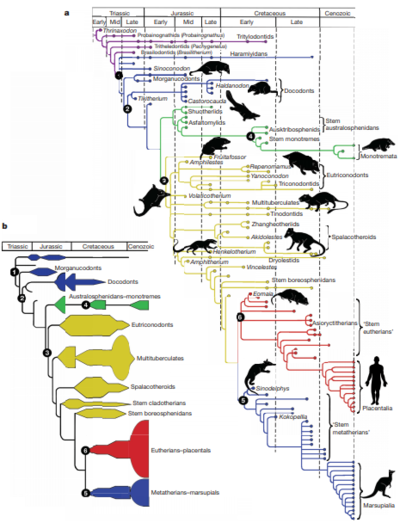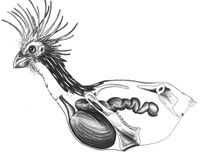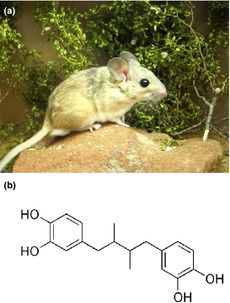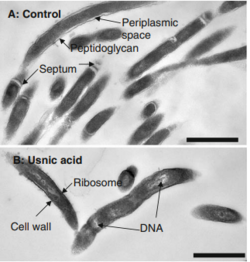Co-Evolution of Microbes and the Mammalian Gut
Introduction

By Joanna van Dyk
Microbes likely had commensal relationships with the ancestors of mammals, long before they evolved to give birth to live young or obtained many of the traits that characterize the class of vertebrates today. [2] The digestive tract of a mammal provides a perfect environment for microbial colonization, it is moist, warm, and has a continuous supply of food. The microbes, in turn, are able to produce toxin-digesting enzymes that allow their hosts to consume a wide variety of nutrients[3]. In fact, vertebrate guts have provided such a unique and hospitable habitat for microbial colonization, that microbial gut populations are more distinct from "external" habitats (such as lakes and soils) than these habitats are from each other[2]. Today, the microbiota of mammalian guts show similarities between species from similar ancestry, but also between those that have similar diets[2].
The earliest mammals were carnivorous, and without microbes, they would have not been able take advantage of the diverse array of nutrients offered by the plant kingdom. This allowed them to fill many of the ecological niches left when the dinosaurs became extinct 65 million years ago.[4] Mammalian gut microbiomes have evolved to aid their hosts in the digestion of plant toxins that would otherwise completely disable them, such as Nordihydroguaiaretic acid. This chemical would cause desert woodrats (N. lepida) to develop kidney cysts and liver damage if its gut bacteria did not digest it for them. [5] Unlike other vertebrates, mammals are in the unique position of being able to inherit their microbiomes from their mothers through the vaginal canal and through breast milk. This may enable the preservation of microbial lineages over time[6]
In this page we adress the questions: How specialized are the microbe lineages associated with mammalian guts? And, when a mammal adopts a diffferent diet, how much does its gut microbiome resemble the microbiomes of its close relatives?
Early Evolution
Colonization of the Gut

Gut Fermentation
Plants are the most abundant source of food on land[4], but they contain complex carbohydrates like cellulose, hemicellulose and lignin that require more enzymatic power to digest. Herbivores have evolved enlarged fermentation chambers in their guts in order to accomodate microbes to help break down resistant starches, as well as to slow down the passage of food so that there is more time for fermentation to occur. These enlarged chambers can be at the end of the digestive system (hindgut, or post-gastric) like inside elephants, rhinos, gorillas and pigs, or at the start (foregut, or pre-gastric), like inside cows, deer, sheep, and kangaroos[8]. Foregut fermenters house their microbes in a chamber before their stomachs, so the microbes are exposed to food that is still highly nutrient dense. Whilst this means host animals must 'sacrifice' some nutrients to their microbes, it also means that they will eventually end up digesting the bacteria that fall into their stomach, so nothing goes to waste[9]. Ruminants utilize bacteria such as Ruminococcus to digest their food. And in some animals (such as cattle) additional fermentation occurs after the stomach, in the large bowel and cesum, where bacteria produce important vitamins[10].

The Hoatzin: a bird with the digestive microbes of a cow
In support for the hypothesis that mammalian gut microbes are largely dependent on diet, one bird that feeds mostly on leaves is a foregut fermenter, and has a similar digestive microbiome to that of cattle[12]. Foregut fermentation occurs mostly in ruminants, such as cows, that have numerous gut chambers and frequently regurgitate and re-chew the contents of their digestive system. The hoatzin is the only bird to have evolved a system of foregut fermentation[12][13]. This is an example of convergent evolution betwen hoazin and ruminants. The hoatzin is native to South America and, unlike most birds, feeds mostly on young leaves. The bird has an enlarged crop that houses a diverse microbiome, including bacteria, archeae, fungi and ciliates, whith bacterial phyla including Firmicutes, Bacteroides, Actinobacteria and Proteobacteria, amoungst others[14] Filipa Godoy-Vitorino, and her colleagues, compared the bacterial composistion of both cow and hoatzin digestive systems in a 2011 study. They found that diet was a larger driver for microbial diversity than phylogenetic lineage. The hoatzin microbiota was more similar to other foregut fermenting animals than the microbiota of chickens and turkeys. However, the cow rumen had higher bacterial richness overall. This could be due to longer retention time of food in the cow rumen, and larger size of the rumen over all[12]. These hypothesis are supported by a study conducted in 2000, showing how the cow rumen was more successful at digesting cellulose than the hoatzin foregut (or crop)[15].
The Residual Foregut in Baleen Whales
In contrast to the hoatzin, baleen whales provide evidence to suggest that phylogeny can play a role in shaping the gut microbiome.
Detoxification of Plant Secondary Compounds
Unlike animals, plants cannot run away from other organisms trying to consume them. Whilst moving prey have evolved fast running legs and meticulous camoflage to evade predators, plants must rely on chemical compounds to avoid being eaten. Plant toxins are diverse, and can do anything to consumers from causing mild digestive discomfort, to triggering abortions and death [4]. These compounds are known as plant secondary metabolites (PSMs), and they have a significant impact on the nutritional ecology of mammals that eat them[3].Whilst herbivores can develop enzymes to digest toxins themselves, mammalian genomes are far slower to evolve than those of tiny, fast-replicating bacteria. Microbes are able to digest almost any compound on the planet[16], and since they evolve so quickly and can horizontally transfer genes between species, they are able to occupy any ecological niche within the mammalian gut. This may be one of the reasons that herbivorous mammals have been so successful in many earth ecosystems[4]. However, studies that specifically address the microbiome as a driver of diet diversification in herbivores have been inconclusive[17].

Detoxification of Creosote resin in Desert Woodrats
Study of the relationship between the gut microbiota in The desert woodrat (N. lepida), and the animals tolerance to PSCs on the creosote bush in the mojave desert, is well doccumented[18][17][5]. The creosote bush (Larrea tridentata) is abundant in the Mojave desert, in the southern United States, because of its resistance to herbivores, drought and ageing [4]. The plant is covered in waxy chemicals that prevent water loss and deter predators. The oldest ring of cloned creosote bushes has been alive for over 11,000 years [19].
Whilst the native population of N. lepida living in the Mojave desert are able to survive on little more than just creosote leaves over the winter and spring months, if a lab rat consumes too much, it dies[20]. Kevin Kohl and his colleagues investigated the differences between woodrat populations in the Mojave desert, where the Creosote bush is present, and the Great Basin Desert, where it is not[5]. Whilst the experienced, creosote eating, Mojave desert population of woodrats tends to express more detoxification enzymes[21], they also have distinct microbial communities in their gut when compared to the woodrats native to the great basin[17]. When Kohl fed the Mojave desert woodrats antibiotics, they were unable to feed on creosote resin and lost >10% of their body mass within 2 weeks, indicating that microbes are largely responsible for the rats' adaptable diet. Conversely, woodrats from the Great Basin population were able to consume only creosote resin whilst maintaining their body weight after recieving a fecal transplant from the experienced rats. Although the specific species responsible for these changes is not known, the antibiotic reduced the abundancy of Spirochaete and Tenericute bacteria[5].
Detoxification of Usnic Acid in Reindeer
Lichens are well known in the microbial world for their iconic symbiosis of fungi and cyanobacteria/green aglae. But they also harbor a poisonous chemical, usnic acid, that provides another examble of microbial detoxification in the mammalian gut. This compound functions as an antibiotic for the lichen, as well as an antifeedant (it causes growth retardation and death in cotton leafworms[22]), it also acts as a UV-absorbing pigment to protect the lichen from solar radiation[23]. Usnic acid is toxic to the liver of rats, mice, and humans, and toxic to the skeletal muscles of ruminants, but reindeer are the only animals able to eat and survive on a diet on only lichens[24][25]. One novel strain of bacteria has been identified as a dominant member of the viable reindier rumen population, Eubacterium rangiferina, a gram-negative, nonmotile rod that was able to actively invade lichen in the lab[25]. Commensal relationships such as these can be immensely valuable, as demonstrated by the deaths of 328 elk in 2004 following the injestion of usnic acid in the tumbleweed sheild lichen[26]. Elk to not have a lichen-resistant gut microbiome, and could not detoxify the usnic acid in Xanthoparmelia chlorochroa when they were left with no other food source.

Sources of Detoxifying Microbes
Behavioural adaptations of herbivores may help them to alter their gut microbiomes in order to cope with plant toxins. Many mammals, including desert woodrats, are known to engage in geophagia (soil consumption) in order to absorb toxins[27]. This is a possible source of detoxifying bacteria, as soil contains many microbes that are able to degrade phenolic compounds[28]. Woodrats are also known to collect and store feces from larger mammals, such as jackrabbits, cows, and coyote[29], this is another potential source of microbe acquisition. The most likely source of detoxifying microbes, however, is from the plants themselves, where bacteria may have already learned to digest the toxins that herbivorous mammals are trying to eat[30]. 24% of microbes found in the guts of Mojave desert woodrats are also found on the surfaces of creosote leaves[5].
Conclusion
References
- ↑ Luo, Zhe-Xi. "Transformation and diversification in early mammal evolution." Nature 450.7172 (2007): 1011-1019.
- ↑ Jump up to: 2.0 2.1 2.2 Ley, Ruth E et al. “Worlds within worlds: evolution of the vertebrate gut microbiota.” Nature reviews. Microbiology vol. 6,10 (2008): 776-88. doi:10.1038/nrmicro1978
- ↑ Jump up to: 3.0 3.1 Dearing, M. Denise, William J. Foley, and Stuart McLean. "The influence of plant secondary metabolites on the nutritional ecology of herbivorous terrestrial vertebrates." Annual review of ecology, evolution, and systematics 36 (2005)
- ↑ Jump up to: 4.0 4.1 4.2 4.3 4.4 Yong, Ed. I contain multitudes: The microbes within us and a grander view of life. Random House, 2016.
- ↑ Jump up to: 5.0 5.1 5.2 5.3 5.4 5.5 Kohl, Kevin D., et al. "Gut microbes of mammalian herbivores facilitate intake of plant toxins." Ecology Letters 17.10 (2014): 1238-1246.
- ↑ Kelley, Scott T., and Susanne Dobler. "Comparative analysis of microbial diversity in Longitarsus flea beetles (Coleoptera: Chrysomelidae)." Genetica 139.5 (2011): 541-550.
- ↑ Stevens, C. Edward, and Ian D. Hume. "Contributions of microbes in vertebrate gastrointestinal tract to production and conservation of nutrients." Physiological reviews 78.2 (1998): 393-427.
- ↑ Karasov, William H., Carlos Martinez del Rio, and Enrique Caviedes-Vidal. "Ecological physiology of diet and digestive systems." Annual review of physiology 73 (2011): 69-93.
- ↑ Ley, Ruth E., et al. "Evolution of mammals and their gut microbes." Science 320.5883 (2008): 1647-1651.
- ↑ Burkholder, Paul R., and Ilda McVeigh. "Synthesis of vitamins by intestinal bacteria." Proceedings of the National Academy of Sciences of the United States of America 28.7 (1942): 285.
- ↑ Grajal, A., and S. D. Strahl. "A bird with the guts to eat leaves." Natural History 8 (1991): 48.
- ↑ Jump up to: 12.0 12.1 12.2 Godoy-Vitorino, Filipa, et al. "Comparative analyses of foregut and hindgut bacterial communities in hoatzins and cows." The ISME journal 6.3 (2012): 531-541.
- ↑ Grajal, Alejandro, et al. "Foregut fermentation in the hoatzin, a neotropical leaf-eating bird." Science 245.4923 (1989): 1236-1238.
- ↑ Godoy-Vitorino, Filipa, et al. "Bacterial community in the crop of the hoatzin, a neotropical folivorous flying bird." Appl. Environ. Microbiol. 74.19 (2008): 5905-5912.
- ↑ Jones, Raymond J., MA Garcia Amado, and M. G. Dominguez-Bello. "Comparison of the digestive ability of crop fluid from the folivorous Hoatzin (Opisthocomus hoazin) and cow rumen fluid with seven tropical forages." Animal feed science and technology 87.3-4 (2000): 287-296.
- ↑ Leahy, Joseph G., and Rita R. Colwell. "Microbial degradation of hydrocarbons in the environment." Microbiology and Molecular Biology Reviews 54.3 (1990): 305-315
- ↑ Jump up to: 17.0 17.1 17.2 Kohl, Kevin D., and M. D. Dearing. "Experience matters: prior exposure to plant toxins enhances diversity of gut microbes in herbivores." Ecology letters 15.9 (2012): 1008-1015.
- ↑ Karasov, William H. "Nutritional bottleneck in a herbivore, the desert wood rat (Neotoma lepida)." Physiological Zoology 62.6 (1989): 1351-1382.
- ↑ Vasek, Frank C. "Creosote bush: Long‐lived clones in the Mojave Desert." American Journal of Botany 67.2 (1980): 246-255.
- ↑ Ríos, Juan Manuel, Antonio Marcelo Mangione, and Jose Carlos Gianello. "Effects of natural phenolic compounds from a desert dominant shrub Larrea divaricata Cav. on toxicity and survival in mice." (2008).
- ↑ Magnanou, E., J. R. Malenke, and M. D. Dearing. "Expression of biotransformation genes in woodrat (Neotoma) herbivores on novel and ancestral diets: identification of candidate genes responsible for dietary shifts." Molecular Ecology 18.11 (2009): 2401-2414.
- ↑ Emmerich, Robert, et al. "Toxicity and antifeedant activity of lichen compounds against the polyphagous herbivorous insect Spodoptera littoralis." Phytochemistry 33.6 (1993): 1389-1394.
- ↑ Bjerke, Jarle Werner, and Tina Dahl. "Distribution patterns of usnic acid-producing lichens along local radiation gradients in West Greenland." Nova Hedwigia 75.3-4 (2002): 487-506.
- ↑ Sundset, Monica A., et al. "Microbial degradation of usnic acid in the reindeer rumen." Naturwissenschaften 97.3 (2010): 273-278.
- ↑ Jump up to: 25.0 25.1 25.2 Sundset, Monica A., et al. "Eubacterium rangiferina, a novel usnic acid-resistant bacterium from the reindeer rumen." Naturwissenschaften 95.8 (2008): 741-749.
- ↑ Roach, John AG, et al. "Determination of usnic acid in lichen toxic to elk by liquid chromatography with ultraviolet and tandem mass spectrometry detection." Journal of agricultural and food chemistry 54.7 (2006): 2484-2490.
- ↑ Krishnamani, Ramanathan, and William C. Mahaney. "Geophagy among primates: adaptive significance and ecological consequences." Animal behaviour 59.5 (2000): 899-915.
- ↑ Blum, Udo, and Steven R. Shafer. "Microbial populations and phenolic acids in soil." Soil Biology and Biochemistry 20.6 (1988): 793-800.
- ↑ Betancourt, Julio L., Thomas R. Van Devender, and Paul Schultz Martin, eds. Packrat middens: the last 40,000 years of biotic change. University of Arizona Press, 1990.
- ↑ Kohl, Kevin D., and M. Denise Dearing. "Wild‐caught rodents retain a majority of their natural gut microbiota upon entrance into captivity." Environmental microbiology reports 6.2 (2014): 191-195.
Authored for BIOL 238 Microbiology, taught by Joan Slonczewski, 2018, Kenyon College.
